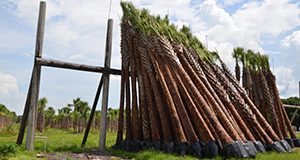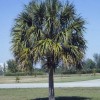 Palms are woody monocots characterized by the production of adventitious roots from the base of the trunk. Unlike the woody roots of dicots, such as oaks, gumbo limbo, and sea grapes, palm roots have no secondary thickening. Also, unlike trees, palms are incapable of repairing damage to their trunks. Most importantly, the life of a palm is dependent upon the continued good health of the single growing bud known as the meristem. Thus, if the palm bud is killed, the entire palm or the palm cane will eventually die. This 4-page fact sheet discusses harvesting and transplanting sabal palms, cropped transplants, and regenerated transplants. Written by Stephen H. Brown and Tim Broschat, and published by the UF/IFAS Environmental Horticulture Department, September 2017.
Palms are woody monocots characterized by the production of adventitious roots from the base of the trunk. Unlike the woody roots of dicots, such as oaks, gumbo limbo, and sea grapes, palm roots have no secondary thickening. Also, unlike trees, palms are incapable of repairing damage to their trunks. Most importantly, the life of a palm is dependent upon the continued good health of the single growing bud known as the meristem. Thus, if the palm bud is killed, the entire palm or the palm cane will eventually die. This 4-page fact sheet discusses harvesting and transplanting sabal palms, cropped transplants, and regenerated transplants. Written by Stephen H. Brown and Tim Broschat, and published by the UF/IFAS Environmental Horticulture Department, September 2017.
http://edis.ifas.ufl.edu/ep543
Tag: Sabal Palm
Sabal palmetto: Sabal or Cabbage Palm
 The sabal palm, or cabbage palm, is native to Florida and coastal regions of North and South Carolina and Georgia, and is the state tree of both South Carolina and Florida. The name “cabbage palm” comes from its edible immature leaves, or “heart,” which has a cabbage-like flavor. This 5-page fact sheet was written by T. K. Broschat, and published by the UF Department of Environmental Horticulture, July 2013.
The sabal palm, or cabbage palm, is native to Florida and coastal regions of North and South Carolina and Georgia, and is the state tree of both South Carolina and Florida. The name “cabbage palm” comes from its edible immature leaves, or “heart,” which has a cabbage-like flavor. This 5-page fact sheet was written by T. K. Broschat, and published by the UF Department of Environmental Horticulture, July 2013.
http://edis.ifas.ufl.edu/st575
Sorting out the Florida Sabal Palms (FOR289/FR357)
 While traveling through the Florida peninsula, a casual observer will notice a wide variety of palms and find that many are called “palmetto.” This 4-page fact sheet helps field investigators identify the four Sabal species found in Florida's natural areas, first by distinguishing them from other fan palms and then from each other. Written by David A. Fox and Michael G. Andreu, and published by the UF Department of School of Forest Resources and Conservation, March 2012.
While traveling through the Florida peninsula, a casual observer will notice a wide variety of palms and find that many are called “palmetto.” This 4-page fact sheet helps field investigators identify the four Sabal species found in Florida's natural areas, first by distinguishing them from other fan palms and then from each other. Written by David A. Fox and Michael G. Andreu, and published by the UF Department of School of Forest Resources and Conservation, March 2012.
http://edis.ifas.ufl.edu/fr357